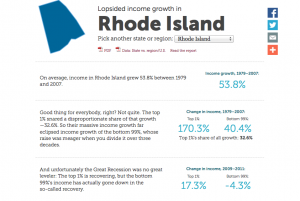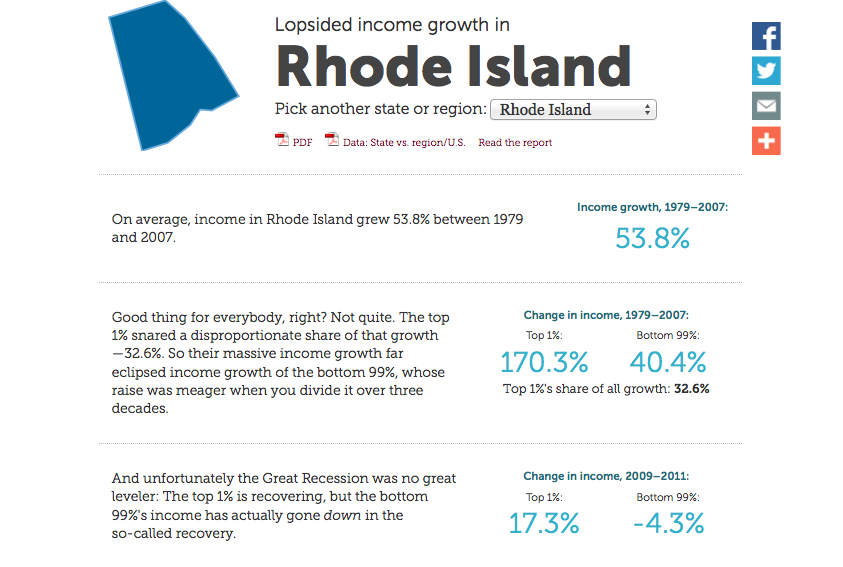 The Economic Policy Institute has release a short issue brief on the Rhode Island Retirement Security Act (RIRSA) by Robert Hiltonsmith that manages to get all of the details right but the big picture entirely wrong.
The Economic Policy Institute has release a short issue brief on the Rhode Island Retirement Security Act (RIRSA) by Robert Hiltonsmith that manages to get all of the details right but the big picture entirely wrong.
The EPI Issue Brief details the differences between the retirement system for state workers before and after the passage of RIRSA as accurately and clearly as I have ever seen. Mr. Hiltonsmith has done a notable job explaining the differences between the new system and the old system.
The brief, unfortunately, fails by engaging in two common fallacies to support its broader conclusions. The first is the straw man fallacy. Mr. Hiltonsmith takes a limited set of the objectives of the entire RIRSA legislation and says defined contribution plans do not meet those objectives. That is true, but ignores the other objectives it does accomplish which were also part of the motivation behind RIRSA. The second is circular reasoning. In this case, Mr. Hiltonsmith states that the reason for a low funding ratio is because the state did not put 100% of its paper liability into the pension fund. This is a tautology and not in dispute and should not be trumpeted as a conclusion of analysis.
Here are his three main points that he believes makes RIRSA a bad policy:
- The defined contribution plan does not save the state money from its annual pension contributions.
- The defined contribution plan is likely to earn lower returns and therefore result in lower benefits for retirees.
- The defined contribution plan does not solve the low funding ratio of the pension plan which exists because law makers did not make required contributions.
Of course, the defined contribution portion of RIRSA was not in place to do any of these three things. The purpose of including a defined contribution plan in the new state pension system is to create stability in annual budget allocations and avoid locking the government into promises it has demonstrated it fails to keep. Defined benefit plans require the state to change pension contributions when there are market fluctuations and leads to anti-cyclical costs, where the state is forced to put substantially more resources into pensions when revenues are lowest and spending on social welfare is most important. The defined contribution plan keeps the payments required by the state consistent and highly predictable. This is far preferable from a budget perspective.
It is unfortunate that there are lower returns to defined contribution plans which may lead to a decrease in overall benefits. It is my opinion that the unions in Rhode Island should be pushing for a substantially better match on the defined contribution portion of their plan that more closely resembles private sector match rates. This could more than alleviate the difference in benefits while maintaining the predictability, for budgeting purposes, of the defined contribution plan. I doubt this policy would have much hope of passing while Rhode Island slowly crawls out of a deep recession, but it is certainly a reasonable matter for future legislatures.
There are only two ways to decrease the current pension fund shortfalls: increase payments to the fund or decrease benefits. There is no structural magic sauce to get around this. Structural changes in the pension system are aimed at reducing the likelihood that the state will reproduce its current situation, with liabilities well outstripping funds. It is true that the “savings” largely came from cutting benefits. I have not heard anyone claim otherwise. The only alternative was to put a big lump sum into the pension fund. That clearly was not a part of RIRSA.
It is absurd to judge RIRSA on the ability of defined contribution plans to achieve policy objectives that are unrelated to the purpose of this structural change.
Perhaps the most troubling conclusion of this brief was that,
The shortfall in Rhode Island’s pension plan for public employees is largely due not to overly generous benefits, but to the failure of state and local government employers to pay their required share of pensions’ cost.
I read that and expected to see evidence of skipped payments or a discussion of overly ambitious expectations for investment returns, etc. Instead, it seems that this conclusion is based simply on the fact that the benefits in Rhode Island were not deemed outrageously large, and therefore Rhode Island should just pay the liability hole. The “failure” here is predicated entirely on the idea that the pensions as offered should be met, period, whatever the cost to the government. This is the “required share”. Which, of course, is technically true without a change in the law, but feels disingenuous. It is essentially a wholesale agreement with the union interpretation of the state pension system as an immutable contract. The courts will likely resolve whether or not this is true. My objection is that Mr. Hiltonsmith makes a definitive statement on this rationale without describing it. In such a lucid description of how the retirement system has changed, it seems this could only be intentional omission intended to support a predetermined conclusion rather than illuminate the unconvinced.
Mr. Hiltonsmith also claims that, “Over the long term, RIRSA may cost the state upwards of $15 million a year in additional contributions while providing a smaller benefit for the average full-career worker.” I am not 100% certain, but based on his use of the normal cost 1 to do these calculations, it appears this conclusion is drawn only based on the marginal contributions to current employees. In other words, if we completely ignore the existing liability, the new plan cost the state more money marginally while potentially decreasing benefits for employees. It is my opinion that Mr. Hiltonsmith is intentionally creating the perception that RIRSA costs more than the current plan while providing fewer benefits. Again, this is true for future liabilities, but ignores that RIRSA also dramatically decreased the unfunded liabilities through cutting existing retiree benefits. So the overall cost for the act is far less, while the marginal cost was increased with the objective of decreasing the instability in government appropriations.
We can have a serious debate about whether there is value in the state goals of a defined contribution plan. In my view, the purpose of switching to this structure is about:
- Portability of plans for more mobile workers, potentially serving to attract younger and more highly skilled employees.
- Stability in government expenditures on retiree benefits from year to year that are less susceptible to market forces. This includes avoiding the temptation to reduce payments when there are strong market returns as well as the crushing difficulty of increasing payments when the market (and almost certainly government receipts) are down.
- Insulating workers from a government that perpetually writes checks they can cash, as was the case with the current system.
This paper does not address any of these objectives or others I might have forgotten. In essence, the brief looks at only one subset of the perceived costs of this structural change, but it is far from a comprehensive analysis of the potential universe of both costs and benefits. In fact, it fails to even address the most commonly cited benefits. That is why I view it as heavily biased and flawed, even if I might draw similar conclusions from a more thorough analysis.





